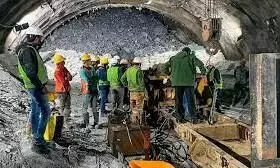The workers’ prolonged confinement within the tunnel is raising serious concerns about their health and well-being.
In a race against time, Uttarkashi’s rescue teams strive to liberate 40 construction workers trapped for over 120 hours after a tunnel collapse. Concerns mount for the well-being of the workers, as elite rescue squads from Thailand and Norway, known for their 2018 Thai cave rescue, join forces. A section of the Silkyara Tunnel crumbled on November 12, leading to the workers’ entrapment. Despite drilling 30 meters into the debris and supplying food and oxygen through five pipes, the urgent mission continues.
As medical experts underscore the imperative for extensive rehabilitation for the entrapped workers, concerns heighten over the necessity for both mental and physical recovery processes due to their prolonged confinement. Dr. Archana Sharma, consultant clinical psychologist at Sri Balaji Action Medical Institute, Delhi, expressed concern about the workers’ traumatic mental state, filled with apprehension, uncertainty, fear, helplessness, and trauma.
Dr. Ajay Agarwal, Director of Internal Medicine at Fortis Hospital, Noida, warned of potential panic attacks arising from extended confinement in an enclosed space. He highlighted the impact of ambient conditions, such as oxygen and carbon dioxide levels, on their physical health, and the risk of hypothermia due to prolonged exposure to cold underground temperatures.
Emphasizing the hazards of construction sites, doctors cautioned about falling debris causing severe injuries, including fractures and open wounds, further complicated by unsanitary conditions. Dr. Ajay Kaul, Chairman of Cardiac Sciences at Fortis Hospital, Noida, stressed the risk of heightened carbon dioxide levels and potential asphyxia, urging attention to breathing problems.
A pivotal moment in the rescue efforts emerged with the deployment of an ‘American auger’ machine, airlifted from New Delhi. Renowned for its efficiency and power, the machine aims to cut through 70 meters of rock, much of which collapsed during rescue efforts, within an estimated 12 to 15 hours. Operating at a “theoretical speed” of 5 meters per hour, this specialized equipment marks a significant turning point in the rescue mission.
The machine arrived in disassembled at the Chinyalisaur airport, located over 30 kilometres from the collapsed tunnel on the Char Dham pilgrimage route. The plan is to utilise this specialized machine to excavate a passage through the debris of the collapsed tunnel section, thereby creating a pathway to reach the trapped workers.
The under-construction tunnel is part of the ambitious Char Dham project, a national infrastructure initiative to enhance connectivity to the Hindu pilgrimage sites of Badrinath, Kedarnath, Gangotri, and Yamunotri.







